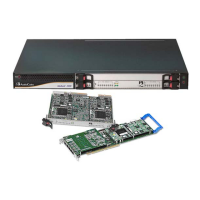Version 5.2 219 September 2007
SIP User's Manual 5. Web-based Management
Table 5-46: Management Settings Parameters
Parameter Description
Syslog Settings
Syslog Server IP address
[SyslogServerIP]
IP address (in dotted format notation) of the computer you are using
to run the Syslog server.
The Syslog server is an application designed to collect the logs and
error messages generated by the VoIP gateway.
Default IP address is 0.0.0.0.
Note: Use the SyslogServerPort parameter to define the Syslog
server's port.
For information on Syslog, refer to the SIP Series Reference Manual.
Syslog Server Port
[SyslogServerPort]
Defines the UDP port of the Syslog server.
The valid range is 0 to 65,535. The default port value is 514.
For information on the Syslog, refer to the SIP Series Reference
Manual.
Enable Syslog
[EnableSyslog]
Sends the logs and error message generated by the gateway to the
Syslog server.
[0] Disable = Logs and errors are not sent to the Syslog server
(default).
[1] Enable = Enables the Syslog server.
Notes:
If you enable Syslog (i.e, EnableSyslog = 1), you must enter an IP
address and a port number using SyslogServerIP and
SyslogServerPort parameters.
Syslog messages may increase the network traffic.
To configure Syslog logging levels, use the parameter
GwDebugLevel.
For information on the Syslog, refer to the SIP Series Reference
Manual.
Trunks Filter Filters syslog messages pertaining to trunks specified in this field.
Only syslog messages belonging to these trunks are reported; the
rest are discarded.
To specify a range of trunks, use commas (,) and / or the minus sign
(-). For example: 0-3,4,6 specifies trunks 0 through 3, and trunks 4
and 6. To specify all trunks, enter '-1'.
Note: Syslog messages that don't include trunk ID are not filtered and
are received regardless of the specified trunk.
SNMP Settings
For detailed information on the SNMP parameters that can be configured via the ini file, refer to
'SNMP Parameters' on page 293.
For detailed information on developing an SNMP-based program to manage your devices, refer to the
SIP Series Reference Manual.
SNMP Trap Destinations Refer to 'Configuring the SNMP Trap Destinations Table' on page
221.
SNMP Community Strings Refer to 'Configuring the SNMP Community Strings' on page 222.
SNMP V3 Table Refer to 'Configuring SNMP V3 Table' on page 224.

